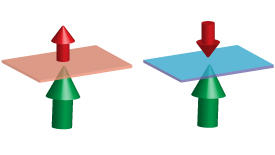

07/28/2014

© 2014 Qinli Ma
Today’s magnetic storage media tend to orient their bits vertically — that is, perpendicular to the thin films that carry them. This arrangement, known as perpendicular magnetic anisotropy, has several advantages over older techniques: it not only lowers the electrical current needed to switch the direction of the bit (and therefore to write information) but also makes the bit more thermally stable.
However, there are some difficulties in using perpendicular magnetic anisotropy. One is the relative difficulty of controlling the magnetic interaction between adjacent films, which is necessary for emerging technologies like spin valves and all-optical data storage. In particular, an antiferromagnetic arrangement, in which the magnetic dipoles of adjacent films point in opposite directions, is difficult to achieve. Now, Qinli Ma and co-workers in the Mizukami Laboratory at the AIMR at Tohoku University have demonstrated a new way of controlling the interaction between adjacent magnetic layers that allows the creation of ferromagnetic or antiferromagnetic arrangements at will1.
The researchers fabricated an interface between two magnetic thin films — one made from manganese and gallium and the other made from iron and cobalt — in which the magnetic bits were defined perpendicular to the films’ plane (see image). As they increased the cobalt content of the iron–cobalt film beyond 25 per cent, the interface between the films abruptly switched from ferromagnetic (with aligned dipoles) to antiferromagnetic.
Ma and co-workers say that this unusual behavior results from the energy structure of their two films. The behavior of the film interface is dominated by the highest-energy electrons in each film. Increasing the cobalt content adds electrons to the iron–cobalt film, thus raising the energy of the highest-energy electrons at the interface. Because the number of available electron states that align antiferromagnetically is greater at higher energies, the film interface switches from ferromagnetic to antiferromagnetic when enough cobalt is added.
Using variations in the density of states to tune the behavior of an interface may prove to be an important new tool in engineering thin-film magnetic systems, says Ma. It also improves the prospects for the use of manganese–gallium films in applications like magnetic random-access memory. In fact, when the researchers used their pair of films to build a memory device called a magnetic tunnel junction, the device performed unusually well. They were able to vary the device’s resistance by 60 per cent at room temperature using magnetic fields alone and by 120 per cent at low temperature, suggesting that practical devices may not be far off.
This research highlight has been approved by the authors of the original article and all information and data contained within has been provided by said authors.